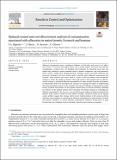| dc.description.abstract | Aflatoxin contamination poses a significant challenge in food safety and security as it affects both health of consumers and supply chains. Due to health impacts associated with aflatoxin contamination, countries have set standards and restrictions for importing food crops and animal feed, resulting in greater economic losses to farmers, transporters, and crop processors. Three controls, namely good farming practices, biological control and public education and awareness campaigns, have been mostly used in countries where aflatoxin contamination has occurred. Since resources are scarce, there is a need to find the optimal and cost-effective strategy to reduce the burden on farmers. This study aimed to find optimal and cost-effective control strategy to mitigated aflatoxin contamination in maize kernels, livestock and humans. A deterministic model was developed and analyzed for studying the impact of implementing three time dependent controls on the dynamics and control of aflatoxin contamination in maize kernels, livestock and humans. We use optimal control theory to find the necessary conditions for existence of the optimal controls and to determine the optimal strategy for controlling the aflatoxin contamination. We also carry out cost-effectiveness analysis through Incremental Cost Effective Ratio (ICER) to obtain the most effective strategy. Simulation results for the optimal control problem suggest that strategy which involve implementation of all controls performs well than other strategies in controlling the aflatoxin contamination in maize kernels, livestock and humans. Therefore, to control aflatoxin contamination initiatives should focus on good farming practices, biological control and public education and awareness campaigns. | en_US |

